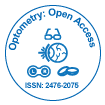Uveal Pathology: Understanding Disorders of the Uveal Tract
Received: 03-May-2025 / Manuscript No. omoa-25-171441 / Editor assigned: 05-May-2025 / PreQC No. omoa-25-171441 / Reviewed: 17-May-2025 / QC No. omoa-25-171441 / Revised: 23-May-2025 / Manuscript No. omoa-25-171441 / Published Date: 29-May-2025 DOI: 10.4172/2476-2075.1000314
Introduction
The uveal tract is a critical component of the eye, consisting of the iris, ciliary body, and choroid. It plays a key role in regulating light entry, producing aqueous humor, and supplying blood to ocular tissues. Disorders affecting the uveal tract, collectively referred to as uveal pathology, can significantly impact vision and ocular health. These conditions range from inflammatory diseases to tumors, infections, and degenerative disorders. Early recognition and management of uveal pathology are essential to prevent complications such as vision loss, glaucoma, or systemic involvement [1,2].
Discussion
Uveal pathology can be broadly categorized into inflammatory, neoplastic, infectious, and degenerative disorders. Inflammatory conditions, such as uveitis, are among the most common. Uveitis involves inflammation of the iris, ciliary body, or choroid and can be anterior, intermediate, posterior, or pan-uveitis depending on the location. It may result from autoimmune diseases, systemic infections, or trauma. Patients often present with redness, pain, blurred vision, photophobia, or floaters. Chronic or recurrent uveitis can lead to complications like cataracts, glaucoma, or macular edema, emphasizing the importance of prompt diagnosis and treatment [3,4].
Neoplastic uveal diseases include benign tumors such as nevi and malignant tumors like uveal melanoma. Uveal melanoma is the most common primary intraocular malignancy in adults and carries a risk of metastasis, particularly to the liver. Early detection via ophthalmoscopic examination, ultrasonography, and imaging modalities such as optical coherence tomography (OCT) is critical for prognosis and treatment planning. Treatment options range from local resection and radiotherapy to enucleation in advanced cases [5-8].
Infectious uveal pathology can arise from bacterial, viral, or parasitic agents. For example, toxoplasmosis may cause posterior uveitis, while viral infections like herpes simplex or cytomegalovirus can trigger anterior or posterior uveitis. Immunocompromised individuals are particularly vulnerable to severe infections, making timely intervention crucial.
Degenerative or systemic conditions, such as diabetic choroidopathy or Vogt-Koyanagi-Harada (VKH) syndrome, also affect the uveal tract. VKH is an autoimmune disorder that leads to bilateral granulomatous uveitis, often accompanied by neurological and dermatological manifestations. Chronic systemic diseases like diabetes or hypertension can compromise choroidal blood flow, contributing to vision impairment [9,10].
Management of uveal pathology requires a multidisciplinary approach. Anti-inflammatory medications such as corticosteroids, immunosuppressive agents, or biologics are commonly used for uveitis. Surgical intervention or radiotherapy may be necessary for tumors. Regular monitoring, imaging, and patient education are key to preventing complications and preserving vision. Emerging technologies like OCT angiography and advanced imaging techniques improve early detection and guide treatment strategies.
Conclusion
Uveal pathology encompasses a wide spectrum of diseases that can threaten vision and overall ocular health. Early diagnosis, accurate classification, and timely management are essential to prevent complications and improve outcomes. With advances in diagnostic imaging, pharmacological treatments, and surgical interventions, the prognosis for many uveal disorders has improved significantly. Awareness of uveal pathology among clinicians and patients alike is crucial to ensure prompt intervention, optimize vision preservation, and maintain overall quality of life.
References
- Behrens A, Doyle JJ, Stern L (2006) Dysfunctional tear syndrome: A Delphi approach to treatment recommendations. Cornea 25: 900–907.
- Nakamura H, Kawakami A, Eguchi K (2006) Mechanisms of autoantibody production and the relationship between autoantibodies and the clinical manifestations in Sjogren's syndrome. Transl Res 148: 281–288.
- Vitali C, Bombardieri S, Jonsson R (2002) Classification criteria for Sjogren's syndrome: a revised version of the European criteria by the American-European Consensus Group. Ann Rheum Dis 61:554-558.
- Smith JA, Albenz J, Begley C (2007) The epidemiology of dry eye disease: report of the epidemiology subcommittee of the international Dry Eye Workshop (2007). Ocul Surf 5: 93–107.
- Miljanovic B, Dana R, Sullivan DA, Schaumberg DA (2007) Impact of dry eye syndrome on vision-related quality of life. Am J Ophthalmol 143: 409–415.
- Schaumberg DA, Sullivan DA, Buring JE, Dana MR (2003) Prevalence of dry eye syndrome among US women. Am J Ophthalmol 136: 318–326.
- Schaumberg DA, Sullivan DA, Dana MR (2002) Epidemiology of dry eye syndrome. Adv Exp Med Biol 506: 989–998.
- Moss SE, Klein RK, Klein BEK (2000) Prevalence of and risk factors for dry eye syndrome. Arch Ophthalmol 118: 1264–1268.
- Gayton JL (2009) Etiology, prevalence, and treatment of dry eye disease. Clin Ophthalmol 3: 405–412.
- Clegg J, Guest J, Lehman A, Smith A (2006) The annual cost of dry eye syndrome in France, Germany, Italy, Spain, Sweden and the United Kingdom among patients managed by ophthalmologists. Ophthalmic Epidemiol 13: 263–274.
Citation: Charlotte J (2025) Uveal Pathology: Understanding Disorders of the Uveal Tract. Optom Open Access 10: 314. DOI: 10.4172/2476-2075.1000314
Copyright: © 2025 Charlotte J. This is an open-access article distributed under the terms of the Creative Commons Attribution License, which permits unrestricted use, distribution, and reproduction in any medium, provided the original author and source are credited.
Select your language of interest to view the total content in your interested language
Share This Article
Recommended Journals
Open Access Journals
Article Tools
Article Usage
- Total views: 57
- [From(publication date): 0-0 - Nov 18, 2025]
- Breakdown by view type
- HTML page views: 37
- PDF downloads: 20
